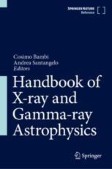Search
Search Results
-
A massive interacting galaxy 510 million years after the Big Bang
James Webb Space Telescope observations have spectroscopically confirmed the existence of galaxies as early as 300 Myr after the Big Bang and with a...

-
Interpretations of the cosmic ray secondary-to-primary ratios measured by DAMPE
Precise measurements of the boron-to-carbon and boron-to-oxygen ratios by DAMPE show clear hardenings around 100 GeV/n, which provide important...

-
Cylindrical Gravitational Pulse Waveguide Excitations
AbstractFollowing the recent observations of gravitational waves by the LIGO-Virgo science team [Phys. Rev. Lett. 116 , 061102 (2016)] resulting from...

-
Tuneable Spectrometer for Submillimeter Astronomy Based on Silicon Fabry–Perot, Preliminary Results
We are studying and develo** high-performance spectroscopy solutions in silicon technology in the framework of instrumental developments around the...

-
Physical Constraints from Broadband Afterglow Fits: GRB000926 as an Example
We develop a model to fit the broadband afterglows of GRBs from the intrinsic parameters of the fireball’s synchrotron emission, and apply it to a...
-
Cosmological model-independent constraints on the baryon fraction in the IGM from fast radio bursts and supernovae data
Fast Radio Bursts (FRBs) are millisecond-duration radio transients with an observed dispersion measure ( DM ) greater than the expected Milky Way...

-
Extremely Red Galaxies: Dust Attenuation and Classification
The “extremely red galaxies” (ERGs) constitute a controversial population in deep near-IR surveys. Their extremely-red observed colours (I...
-
Herschel investigation of cores and filamentary structures in L1251 located in the Cepheus flare
Molecular clouds are the prime locations of star formation. These clouds contain filamentary structures and cores which are crucial in the formation...

-
Application of VR simulation and image optical processing in image visual communication design
As a new technical model, language is integrated into layout, text, illustration and graphics, thus forming the art of visual communication. In the...

-
Astrospheres of Planet-Hosting Cool Stars and Beyond ⋅ When Modeling Meets Observations
Thanks to dedicated long-term missions like Voyager and GOES over the past 50 years, much insight has been gained on the activity of our Sun, the...

-

-
Nested dust shells around the Wolf–Rayet binary WR 140 observed with JWST
Massive colliding-wind binaries that host a Wolf–Rayet (WR) star present a potentially important source of dust and chemical enrichment in the...

-
The Milky Way revealed to be a neutrino desert by the IceCube Galactic plane observation
The Galactic diffuse emission (GDE) is formed when cosmic rays leave the sources where they were accelerated, diffusively propagate in the Galactic...

-
Detection of interstellar cyanamide (NH\(_{2}\)CN) towards the hot molecular core G10.47\(+\)0.03
In the interstellar medium, the amide-type molecules play an important role in the formation of prebiotic molecules in the hot molecular cores or...

-
Supernova Remnants: Types and Evolution
Although only a small fraction of stars end their lives as supernovae, all supernovae leave behind a supernova remnant (SNR), an expanding shock wave...
-
Feedback from Quasars in Galaxy Formation
Several observational pieces of evidence and theoretical arguments suggest that feedback from accreting black holes is an unavoidable ingredient in...
-
Extragalactic Science with the Orbiting Astronomical Satellite Investigating Stellar Systems (OASIS) Observatory
The Orbiting Astronomical Satellite for Investigating Stellar Systems (OASIS) , a proposed Astrophysics MIDEX-class mission concept, has an innovative...

-
Enhanced star formation through the high-temperature formation of H2 on carbonaceous dust grains
The microphysics of molecular hydrogen formation has an influence on galactic-scale star-formation rates over cosmic time. H 2 is the cooling agent...

-

